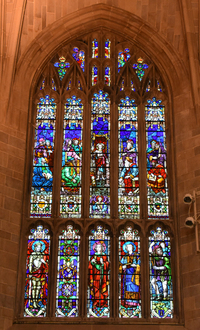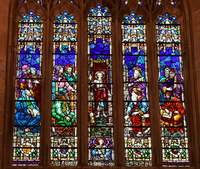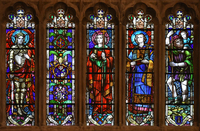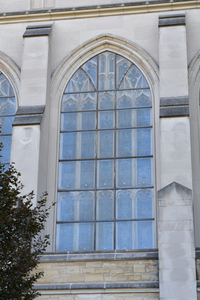Window
Building Name: Cathedral of the Most Blessed SacramentStudio Name: Willet Hauser Architectural Glass
City: Detroit
Window Shape: 6 (gothic arched, more than 2 vertical sections)
Subject/Title of Window: Christ in the Temple
Brief Description of Subject: The canopy topping this 5 panel window is decorative in nature highlighted by angels with censors.
The scene below is topped with decorative inscriptions based on Matt. 28:4-5 -- the resurrection scene where the two Mary's had come to anoint the body of Jesus and an angel appeared at the tomb "And for fear of him the guards trembled and became like dead men. But the angel said to the woman 'Do not be afraid, for I know you seek Jesus.'" The scene is "Christ in the Temple" and is covered in Luke 2:41-52 -- The Holy Family had traveled to Jerusalem for Passover and on the return trip his parents could not find him. "And not finding him, they returned unto Jerusalem, seeking him. And after three days, they found him in the temple, sitting in the midst of the doctors, hearing them, and asking them questions. And all that heard him were astonished at his wisdom and answers. ..... and Jesus advanced in wisdom and grace with God and Man." Behind Jesus is the Temple's veil that will be torn asunder when Jesus dies on the cross; I was not able to read the inscription on the veil.Below the scene are decorative coats-of-arms as befitting a Norman styled church as well as an angel holding the torah.
In the lower portion of the window is found four saints with the artist's creation of their coat-of-arms as well as a decorative panel.
St. George of Lydda was a Roman legionary during the persecution of Diocletian; he preached the Word of God and was martyred in 303 for his faith. A legend arose that a dragon had taken over a city and to appease the dragon the citizens turned over a princess to be killed and as she approached the dragon, St. George, riding a white horse and dressed in shining armor, slew the dragon and saved the princess. From the blood of the dragon grew a rose bush and St. George plucked off a rose and gave it to the princess. Based on this legend he became the patron saint of England. His attributes seen here include costumed as a medieval knight and roses in the coat-of-arms.
Decorative panel with Christian icons is inscribed "Praise Him."
St. John the Evangelist was one of the original apostles and noted for writing a gospel as well as the Apocalypse. His attributes seen here include depicted as a young beardless man, and holding a chalice. The chalice stems from a legend that a pagan priest tried to kill him by giving him a poisoned cup of wine; when John took the cup the poison turned into a snake and crawled out of the cup.
St. Nicholas of Tolentine (1249-1305) His parents wanted a child and had a dream to go to the city of Bari; once there they dreamed that Bishop Nicholas of Bari (aka Santa Claus) told them they would have a son who would become a great preacher. When they had that son his parents named him "Nicholas" after the Bishop. He became an Augustinian friar and once when he was sick from fasting, the Virgin Mary appeared to him and gave him a piece of bread soaked in water. Bread soaked in water became known as "St. Nicholas' bread" and was given to the sick; many miracles have been ascribed to it. His attributes seen here include depicted as a young beardless man, a book (preacher), and in his coat-of-arms, wheat (bread). I do not know why he is not costumed as an Augustinian friar.
St. Christopher, born in the 4th Century with the name "Reprobus", was a strong man who wanted to serve the most powerful king. When he found out the mighty king was afraid of the devil, Reprobus decided to serve the devil but when the devil was afraid of the Cross he decided to serve Christ. A preacher of the Gospel, noting how strong Reprobus was, told him he could best serve Christ by ferrying travelers across a nearby dangerous river that had killed many who attempted to cross it. One day a child asked to be carried across the river, Rebrobus struggled to get him across the river as it seemed he had the weight of the world on his shoulders. When they reached the other side the child identified himself as Christ and as a sign told him his staff would sprout flowers. Reprobus was then baptized with the name "Chistopher" which means "bearer of Christ". His attributes seen here include standing in a river, carrying Christ on his shoulders, a staff, and a ferryman's bell in the coat-of-arms.
From the Guide to the Cathedral of the Most Blessed Sacrament, Copyright 1958, Archdiocese of Detroit.
This window reconstructs the scene when Christ, at the age of twelve, was found by His mother and foster-father in the Temple. The center panel shows Him standing unafraid in the midst of the doctors and lawyers of the Jewish Law, “hearing Him and asking questions.” In the panel at the left are Joseph and Mary, to the right, the Jewish teachers. In the lower panels are St. George, St. John, St. Nicholas, and St. Christopher.
Inscriptions: Jesus Advances in Wisdom and Grace with God and Man
Height: 25'
Width: 12'
Christ in the Temple
Christ in the Temple scene
Christ in the Temple, Saints
Christ in the Temple outside
The MSGC is a constantly evolving database. Not all the data that has been collected by volunteers has been sorted and entered. Not every building has been completely documented.
All images in the Index are either born-digital photographs of windows or buildings or are scans of slides, prints, or other published sources. These images have been provided by volunteers and the quality of the material varies widely.
If you have any questions, additions or corrections, or think you can provide better images and are willing to share them, please contact donald20@msu.edu






